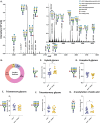ASGR1 deficiency improves atherosclerosis but alters liver metabolism in ApoE-/- mice
- PMID: 39616371
- PMCID: PMC11608471
- DOI: 10.1186/s12933-024-02507-5
ASGR1 deficiency improves atherosclerosis but alters liver metabolism in ApoE-/- mice
Abstract
The asialoglycoprotein receptor 1 (ASGR1), a multivalent carbohydrate-binding receptor that primarily is responsible for recognizing and eliminating circulating glycoproteins with exposed galactose (Gal) or N-acetylgalactosamine (GalNAc) as terminal glycan residues, has been implicated in modulating the lipid metabolism and reducing cardiovascular disease burden. In this study, we investigated the impact of ASGR1 deficiency (ASGR1-/-) on atherosclerosis by evaluating its effects on plaque formation, lipid metabolism, circulating immunoinflammatory response, and circulating N-glycome under the hypercholesterolemic condition in ApoE-deficient mice. After 16 weeks of a western-type diet, ApoE-/-/ASGR1-/- mice presented lower plasma cholesterol and triglyceride levels compared to ApoE-/-. This was associated with reduced atherosclerotic plaque area and necrotic core formation. Interestingly, ApoE-/-/ASGR1-/- mice showed increased levels of circulating immune cells, increased AST/ALT ratio, and no changes in the N-glycome profile and liver morphology. The liver of ApoE-/-/ASGR1-/- mice, however, presented alterations in the metabolism of lipids, xenobiotics, and bile secretion, indicating broader alterations in liver homeostasis beyond lipids. These data suggest that improvements in circulating lipid metabolism and atherosclerosis in ASGR1 deficiency is paralleled by a deterioration of liver injury. These findings point to the need for additional evaluation before considering ASGR1 as a pharmacological target for dyslipidemia and cardiovascular disorders.
Keywords: Asialoglycoprotein receptor 1; Atherosclerosis; Cholesterol; Liver metabolism; Plaque composition.
© 2024. The Author(s).
Conflict of interest statement
Declarations. Competing interests: The authors declare no competing interests.
Figures





References
Publication types
MeSH terms
Substances
Grants and funding
- LDD/EAS Competitive Grant
- (PRIN-PNRR 2022 P202294PHK to AB)/Progetti di Rilevante Interesse Nazionale
- (PRIN 2022 2022NBKCWP to FB)/Progetti di Rilevante Interesse Nazionale
- (PRIN 2022 7KTSAT to GDN)/Progetti di Rilevante Interesse Nazionale
- (project Proteoform-resolved pharmacokinetics of biopharmaceuticals, no. 019.012)/Dutch Research Council (NWO) in the framework of the ENW PPP Fund for the top sectors
- (project Proteoform-resolved pharmacokinetics of biopharmaceuticals, no. 019.012)/Dutch Research Council (NWO) in the framework of the ENW PPP Fund for the top sectors
- (European Commission Ref EUROPEAID/173691/DD/ACT/XK to GDN, GB)/Nanokos
- (European Commission Ref EUROPEAID/173691/DD/ACT/XK to GDN, GB)/Nanokos
- (1560-2019 to FB)/Fondazione Cariplo
- (2022 to FB)/Fondazione Roche
- (RF-2019-12370896 to GDN)/Ricerca Finalizzata, Ministry of Health
- (Progetto CN3 - National Center for Gene Therapy and Drugs based on RNA Technology to GDN)/PNRR Missione 4
- (PNRR-MAD-2022-12375913 to GDN)/PNRR Missione 6
- (GA N° 101095426 of the EU Horizon Europe Research and Innovation Programme to GDN)/CARDINNOV, Ministry of Research and University under the umbrella of the Partnership Fostering a European Research Area for Health (ERA4Health)
LinkOut - more resources
Full Text Sources
Medical
Miscellaneous

